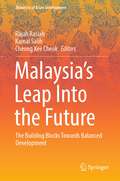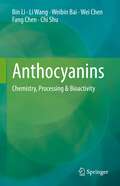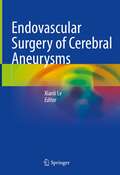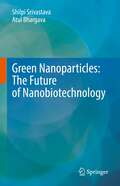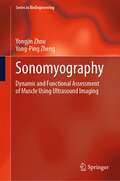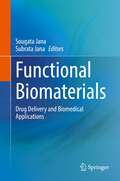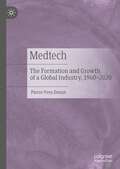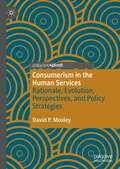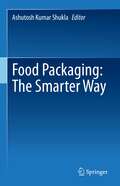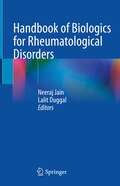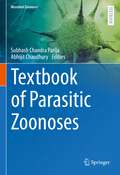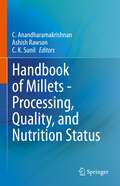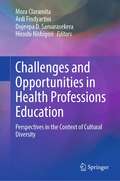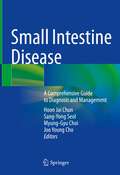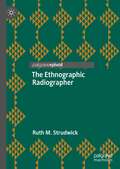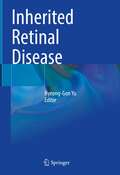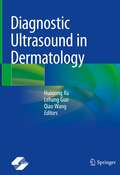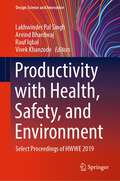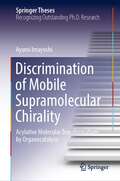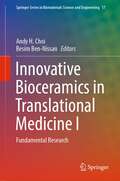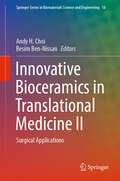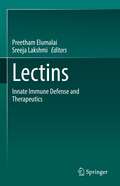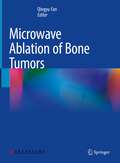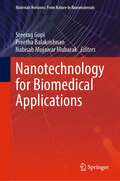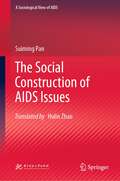- Table View
- List View
Malaysia’s Leap Into the Future: The Building Blocks Towards Balanced Development (Dynamics of Asian Development)
by Rajah Rasiah Kamal Salih Cheong Kee CheokThis book presents the future development of Malaysia. It puts together building blocks to achieve a better future. These blocks are poverty and income inequality, population, demography and urbanization, growth and technological progress, education, human capital and skills, finance, labor, the environment, and health care. It examines the reasons for the decline in the agricultural sector with an emphasis on food security. It discusses Malaysia’s economic growth and structural change compared to some of the Northeast East Asian and Southeast Asian countries. It explains the projections of population and demographic change and its bearing on government policies. It evaluates the country’s education sector and discusses the strategies to improve its role in the country further. It argues for replacing ethnic-based approaches with a needs-based system for the future direction to build a plural Malaysia. This insightful book is of interest across several fields, including demography, economic development, and urbanization.
Anthocyanins: Chemistry, Processing & Bioactivity
by Bin Li Fang Chen Wei Chen Li Wang Weibin Bai Chi ShuThis book summarizes the current knowledge of anthocyanins, provides systematic information for future exploration of anthocyanin applications. It focuses on several aspects regarding the studying progression in the field of anthocyanins. The first section of the book provides a brief introduction to the scope and progress on anthocyanins, which is followed by the second section that describes the natural sources, structure, extraction approaches, bioavailability, and current stabilizing approach of anthocyanins. Then in the third part, the book focuses on the industrial processing of anthocyanins in foods by discussing the impact of food processing on anthocyanin structure and composition as well as classical processing techniques on anthocyanin-containing foods, including high-pressure, encapsulation, microwave, and combined application of the above techniques. In the last section of the book, the authors explore the currently most popular application of anthocyanins in improving human health, such as the effect of anthocyanin on vision, metabolism, neural system, cardiovascular system, and cancers. The book will facilitate readers’ understanding of the progress of anthocyanin studies. And it will benefit researchers and graduate students in the fields of natural products, functional food, and nutrition, etc.
Endovascular Surgery of Cerebral Aneurysms
by Xianli LvThis book provides recent progress of neuroendovascular surgery, which is a minimally invasive treatment of cerebral aneurysms. Great advances have been made in the techniques, devices and large randomized clinical trials showing striking therapeutic benefit for cerebral aneurysms. The treatment of cerebral aneurysms has also seen substantial evolution, increasing the number of aneurysms that can be treated successfully with minimally invasive therapy. In the 17 chapters, authors introduce the techniques, devices, device structures and therapeutic concepts. Attendings, fellows, residents, medical students or anyone interested in sharpening their diagnostic and therapeutic skill set will benefit from reading this text. This book will include many clinical cases and skills and clinical concepts, which will benefit professional /practitioner.
Green Nanoparticles: The Future of Nanobiotechnology
by Shilpi Srivastava Atul BhargavaThis book discusses the fundamental concepts of the green synthesis of nanoparticles and presents the latest advances in this emerging field. Providing a comprehensive overview of developments related to nanoparticle synthesis using fungi, algae, bryophytes, pteridophytes, gymnosperms, monocotyledons, dicotyledonous (angiosperms) and animal systems, it also explores techniques for the characterization of these nanoparticles. Lastly, it reviews the applications and toxicity of biologically synthesized green nanoparticles. Given its scope, it is a valuable resource for students, researchers and policymakers working in the field of nanobiotechnology and nanoscience.
Sonomyography: Dynamic and Functional Assessment of Muscle Using Ultrasound Imaging (Series in BioEngineering)
by Yongjin Zhou Yong-Ping ZhengThis book explains the exciting field of sonomyography (SMG), which makes it possible to use continuous signals detected by ultrasound images in real time to evaluate muscle functions. After an introduction, the book discusses the methods to extract and analyse different SMG signals, including muscle thickness, penetration angle, fascicle length, contraction activity, and muscle cross-sectional areas, etc. It then describes the mono-modal applications of sonomyography: posture recognition, prosthesis control, muscle training, muscle strength (fall risk assessment), fatigue assessment, and the assessment of dysfunctional muscles. The book also shows how to combine sonomyography with additional muscle assessment methods, in particular EMG, MMG, and motion sensors. Lastly, it provides an overview of the potential applications in sport science, rehabilitation, fitness, and elderly health.
Functional Biomaterials: Drug Delivery and Biomedical Applications
by Sougata Jana Subrata JanaThis book explores in depth a wide range of functional biomaterials-based systems for drug, gene delivery, and biomedical aspects. The chapters cover newer technologies such as polymeric micelle, pH-responsive biomaterials, stimuli-responsive hydrogels, silk fibroin, inorganic biomaterials, synthetic biomaterials, 3D printed biomaterials, metallic biomaterials, ceramic and hybrid biomaterials. It also describes the theranostic approaches for cancer therapy, the biomaterials-based nanofibers scaffolds in tissue engineering, as well as the strategies applications of metallic biomaterials for the medical and dental prosthetic field. This newer and updated approach will be attractive for biomedical engineering students working on materials science in the development of novel drug delivery strategies. The book will be an important reference for researchers and professionals working on biomaterial research in the pharmaceutical and medical fields.
Medtech: The Formation and Growth of a Global Industry, 1960–2020
by Pierre-Yves DonzéThis book offers an analysis of the dynamics of the global medical device (medtech) industry from the 1960s until the present, using the approaches of business history and industry studies. While most of the publications in the corresponding field have focused on particular countries/regions or actors, this research is unique in its scope. First, it explores the formation and development of medtech business both globally and in the major countries engaged in this industry (the United States, Japan, Germany, Switzerland, France, and China). Second, it tackles a broad range of actors and organizations, from individual entrepreneurs, medical doctors, and engineers to small family firms, start-ups, and large multinationals, as well as universities and research centers. Hence, for the first time, this book both provides a general understanding of the formation and transformation of the medtech industry throughout the world and sheds light on the main features of a fast-growing business in the twenty-first century. This book will be of value to historians, industry professionals, and analysts.
Consumerism in the Human Services: Rationale, Evolution, Perspectives, and Policy Strategies
by David P. MoxleyThis book captures the evolution of consumerism in the human services. By addressing the changing roles and contributions of consumers (those working within human service organizations and systems and those working outside of those organizations and systems) the author offers an encompassing framework of consumerism. This framework is multidimensional and incorporates multiple types and forms of consumerism. The author offers a rationale for consumerism in the human services, illustrates its evolution, and considers multiple perspectives and models culminating in policy considerations, including specific strategies. This book will equip consumers, survivors, practitioners, and policy makers with substantive knowledge of how to advance human services through action and innovation.
Food Packaging: The Smarter Way
by Ashutosh Kumar ShuklaThis book reviews the science and technology of food packaging and covers the potential innovations in the food packaging sector. At the same time, it highlights the issues and prospects for linking the laboratory research to the market. In addition to typical packaging requirements such as food quality, shelf life, protection, communication, and marketing, the book emphasizes the need for novel packaging materials, including biodegradable packaging for a variety of food products. A wide range of food products has been kept in focus and includes animal-based food products such as dairy products and sea foods. The book presents the next level of packaging solutions i.e., smart packaging with the applications of potential tools such as intelligent and active packaging, and includes the latest research on emerging digital technologies for packaging development, assessment, and acceptability. It further highlights the strategies including blends, reinforcing agents, cold plasma, UV light applications, chemical, and enzymatic methods and explores the new opportunities leading to improvement in the packaging performance. Smart freshness indicator applications, including gas and time-temperature indicators for quality and safety of packaged products, have been covered in detail. The book also includes the functional characteristics of edible films and coatings, including their bioactive characteristics. Finally the book presents the rules and regulation related to packaging.
Handbook of Biologics for Rheumatological Disorders
by Neeraj Jain Lalit DuggalBiologics have revolutionized the treatment of autoimmune diseases due to their efficacy, speed of onset, and tolerability. The development of new agents and expanded use of existing agents continues to be a highly active area of investigation among rheumatic diseases, with a multitude of innovative therapeutic strategies in various stages of development. Although the story of treatments continues rapidly, therapeutic research in some conditions is hindered by the rarity of the disease, variation in phenotype, and concerns about toxicity. This fast-paced development of therapeutics,necessitates immediate evaluation of individual biologic agents and their best use in the new treatment regimens.This book provides an inclusive approach with the existing evidence concerning effectiveness and implications on the usage of biologics in treating various rheumatologic disorders. It also covers the evidence behind the rational use of these agents in varied autoimmune diseases. This manual also offers a complete overview of the existing & futuristic biologic treatments, and draws recommendations on how to standardize the most suitable regimen for a specific patient in the context of current guidelines. The handbook of Biologics in Rheumatology serves as a present and concise compendium to the modern therapeutic developments in the field.This book is likely to benefit clinicians, residents, fellow and other healthcare workers dealing with rheumatological disorders, and also hard-core Rheumatologists, who are looking for a quick recap of Biologics of their interest.
Textbook of parasitic zoonoses (Microbial Zoonoses)
by Subhash Chandra Parija Abhijit ChaudhuryThis textbook, which is the first volume in the series Microbial Zoonoses, provides a comprehensive overview of the diagnosis, treatment and control of zoonotic parasitic diseases. The book is divided into two sections; the first section discusses the classification of parasitic zoonoses and includes general information on the diagnosis, treatment, epidemiology, prevention, and control of parasitic zoonoses. It also describes the biological features of these organisms, host-parasite interactions, and the disease spectrum, as well as the importance of public health control measures, such as surveillance, and prophylactic measures in controlling these diseases.The second section explores the important zoonotic diseases caused by ectoparasites, protozoan and helminths parasites. It also reviews the life cycle, pathogenesis, pathology, immunology and clinical manifestations, modern diagnostic methods, treatment regimen, prevention, control, and epidemiology of these parasites.Cutting across the disciplines, this book serves as a guide to postgraduate students, faculty members, public health experts, and medical administrators who are interested in the management of these parasitic zoonotic infections.
Handbook of Millets - Processing, Quality, and Nutrition Status
by C. Anandharamakrishnan Ashish Rawson C. K. SunilThe book offers an updated perspective on the unique characteristics of millets. Millets are consumed for their health/nutritional benefits, and in the preparation of specialty foods for target groups – from pediatrics to geriatrics. Recent trends suggest the importance of millet in the human diet due to their nutritional importance, ability to grow in high temperatures and drought conditions, and their resistance to pests and diseases. This book highlights different types of millet and discusses their properties as well as nutritional and anti-nutritional values. In addition, the book also provides information on the physiochemical properties, future prospects, current methodologies, and agricultural practices. The last few parts cover the emerging technologies in millet processing, by-products utilization, quality standards, and the current millet industry scenario. The book provides a comprehensive overview of the status of millet processing, quality, and nutraceutical product manufacture. The book is a resourceful read for students and researchers in food sciences, as well as industry experts.
Challenges and Opportunities in Health Professions Education: Perspectives in the Context of Cultural Diversity
by Mora Claramita Ardi Findyartini Dujeepa D. Samarasekera Hiroshi NishigoriThis book addresses health professions educational challenges specific to non-Western cultures, implementing a shifting paradigm for educating future health professionals towards patient-centered care. While health professions education has received increasing attention in the last three decades, promoting student-centered learning principles pioneered by leaders in the medical community has, for the most part, remain rooted in the Western context. Building from Hofstede’s analysis of the phenomena of cultural dimensions, which underpin the way people build and maintain their relationships with others and influence social, economic, and political well-being across nations, this book demarcates the different cultural dimensions between East and West, applied to medical education. The respective ‘hierarchical’ and ‘collectivist’ cultural dimensions are unpacked in several studies stemming from non-western countries, with the capacity to positively influence healthcare education and services. The book provides new insights for researchers and health professional educators to understand how cultural context influences the input, processes, and output of health professionals’ education. Examples include how cultural context influences the ways in which students respond to teachers, how teachers giving feedback to students, and the challenges of peer feedback and group work. The authors also examine causes for student hesitation in proposing ideas, the pervasive cultural norm of maintaining harmony, the challenges of teamwork in clinical settings, the need to be sensitive to community health needs, the complexity of clinical decision making, and the challenge of how collectivist cultural values play into group dynamics. This book aims to advocate a more culturally-sensitive approach to educating health professionals, and will be relevant to both students and practitioners in numerous areas of public health and medical education.
Small Intestine Disease: A Comprehensive Guide to Diagnosis and Management
by Hoon Jai Chun Sang-Yong Seol Myung-Gyu Choi Joo Young ChoThis book covers all aspects of small intestinal disease with the aim of providing an up-to-date reference of the highest quality that will assist in everyday clinical practice. After introductory chapters on anatomy, pathophysiology, epidemiology, and signs and symptoms, the roles of different imaging modalities in the diagnosis of small intestinal disease are clearly explained, focusing particularly on capsule endoscopy, device-assisted enteroscopy, CT and MR enterography, and nuclear medicine techniques. A series of chapters then address each of the diseases and conditions that may be encountered. The coverage is wide ranging, including, for example, obscure gastrointestinal bleeding, Crohn’s disease and other inflammatory conditions, celiac disease, Behçet’s disease, Meckel’s diverticulum, intestinal tuberculosis, and various malignancies. Numerous informative clinical cases are presented to identify characteristic imaging findings and assist in treatment decision making. Small intestinal disease continues to represent a significant challenge. The scope and detail of this book will make it an invaluable asset for gastroenterologists and other clinicians.
The Ethnographic Radiographer
by Ruth M. StrudwickWritten from the perspective of a diagnostic radiography educator, this book introduces readers to ethnography as a methodology and examines how an ethnographic researcher sees the world in which they live.
Inherited Retinal Disease
by Hyeong-Gon YuThis book presents the latest knowledge and expert guidance on all aspects of inherited retinal diseases, including molecular genetics, diagnosis, clinical features, general principles of treatment, novel treatment methods, and genetic counseling. Recent years have witnessed great advances in understanding of the genetic and cytological background of these diseases. Genetic analysis methods such as next generation sequencing have remarkably reduced the cost and time required for massive analysis of patients’ samples. Studies on gene therapy and stem cell therapy have been successfully carried out in animal models, and gene therapy is now available for Leber congenital amaurosis caused by RPE65 mutations. Against this background, Inherited Retinal Disease will be an invaluable up-to-date resource for ophthalmologists, medical students, and researchers in ocular inflammation. In addition to supplying essential information on each individual disorder, it features many interesting cases contributed by global leaders in the field as well as clinical photographs obtained with newer imaging techniques and numerous images of rare but clinically important diseases.
Diagnostic Ultrasound in Dermatology
by Huixiong Xu Lehang Guo Qiao WangThis book offers readers details in application of high-frequency ultrasound in dermatology, a new method playing increasingly important roles in diagnosis of skin diseases. At first, chapters introduce anatomy and ultrasound features of normal skin. Then terminology, image quality, and artifact of dermatologic ultrasound are presented. After that, ultrasound features of benign and malignant skin tumors, inflammation, autoimmune disease, and traumas are described with diagnostic tips for specific disease. It will be a valuable reference book not only for dermatologist and radiologist, but also for plastic surgeon and cosmetologist.
Productivity with Health, Safety, and Environment: Select Proceedings of HWWE 2019 (Design Science and Innovation)
by Rauf Iqbal Vivek Khanzode Arvind Bhardwaj Lakhwinder Pal SinghThis volume comprises select proceedings of the International Conference on Humanizing Work and Work Environment organized by the Indian Society of Ergonomics (HWWE2019). The book presents research findings on different areas of ergonomics for developing appropriate tools and work environment considering capabilities and limitations of working people for maximum effectiveness on their performance. This volume will be of interest to academics, professionals and practitioners in the field of ergonomics.
Discrimination of Mobile Supramolecular Chirality: Acylative Molecular Transformations by Organocatalysis (Springer Theses)
by Ayumi ImayoshiThis book proposes a novel concept for molecular recognition. In the field of asymmetric synthesis approaching the mature science, asymmetric discrimination and catalytic synthesis of chiral supramolecules still stand as unsolved problems. The extreme difficulty in asymmetric synthesis of such supramolecules may result from the mobile nature of supramolecular chirality. Here the author shows the first highly enantioselective synthesis of mechanically chiral supramolecules. In the presence of a chiral organocatalyst, a mechanically planar chiral rotaxane was obtained with p erfect enantiopurity (>99% ee) with an excellent selectivity. The dynamic and flexible recognition mode enabled asymmetric synthesis of supramolecules with conformational flexibility and mobility. The recognition mode of the catalyst is a contrast to the traditional static and rigid recognition mode of the typical conventional catalysts. The concept of dynamic molecular recognition will be adopted as a novel concept in a wide range of fields beyond the field of organic chemistry, including material chemistry, biochemistry, and medicinal chemistry.
Innovative Bioceramics in Translational Medicine I: Fundamental Research (Springer Series in Biomaterials Science and Engineering #17)
by Andy H. Choi Besim Ben-NissanThis book is part of a two-part volume book that highlights the latest advances in innovative bioceramics applied in the highly interdisciplinary area referred to as “translational medicine”. This volume covers the basic principles and techniques used in the manufacture of bioceramics and biocomposites for various biomedical applications including drug delivery, implantable bionics and the development of the cardiac pacemaker, and bone tissue engineering. Furthermore, self-healing materials have been attracting increasing interest in both engineering and medical applications during the past two decades. Self-healing hydrogels are particularly interesting because of their ability to repair structural damages and recover their original functions, specifically in tissue engineering.
Innovative Bioceramics in Translational Medicine II: Surgical Applications (Springer Series in Biomaterials Science and Engineering #18)
by Andy H. Choi Besim Ben-NissanThis book is part of a two-part volume book that highlights the latest advances in innovative bioceramics applied in the highly interdisciplinary area referred to as “translational medicine”. This volume predominantly written by surgeons in the fields of craniomaxillofacial, orthopedics, and spinal surgery, examines the translation of innovative bioceramics and bioceramics-based composite from the laboratory to a personalized surgical environment for the repair of damaged and diseased bone tissues. This book also covers the topic of osteoporosis, a skeletal disorder in which the World Health Organization (WHO) has recognized it as a public health emergency due to the high number of subjects who exhibited the disease and the morbidity and mortality related to fractures. The book caters to biomaterials researchers and medical clinicians who are interested in incorporating innovative bioceramics to the above-mentioned applications.
Lectins: Innate immune defense and Therapeutics
by Preetham Elumalai Sreeja LakshmiThis book reviews the relationship between receptors, carbohydrate moieties, and pathogenic surfaces and lectins’ pathophysiology of immune responses and examines the mechanisms of action of the molecules for the treatment potentials. Increasing evidence has suggested that lectin-carbohydrate interactions perform important roles in various regulations of immune responses, but much remains to be learned about these crucial properties and their interplay with other molecules. In addition, a better understanding of the structural and functional properties of lectin and the activated immune response will be of critical importance for the development of new diagnostic tools and therapeutic strategies. These key areas are the focus of this book, which documents the latest research findings in the field. Evidence is provided for the various lectin types from animal and plant as well as microbial or marine lectins, and this wide range of molecular knowledge directs us to various diseases, including infectious diseases and cancer. In presenting state-of-the-art knowledge on the interactions between lectin and its interactions,the book will help to pave the way for the development of novel targets for the prevention and treatment of many disorders.
Microwave Ablation of Bone Tumors
by Qingyu FanThe book provide up-to-date information on clinical application of microwave ablation for limb salvage in bone tumors. First chapters briefly introduce clinical diagnosis, stage, amputation and limb salvage surgery of bone tumors. In the following chapters, detailed procedure of microwave ablation of bone tumors in various parts of the body, for example, upper limb, lower limb, pelvis and spine, is described, accompanying a large number of high-resolution illustration. Microwave ablation of different kinds of bone tumors, for example, bone metastases, giant cell tumor, osteosarcoma, soft tissue tumors is also presented with tips in clinical procedure. In the closing chapters, joint function preservation, prevention and treatment of complications, and the advantages and disadvantages of microwave ablation of bone tumors are also discussed for reader to have a in-depth understanding. It will be a valuable reference for orthopedic surgeons and oncologists, as well as practitioners interested in this field.
Nanotechnology for Biomedical Applications (Materials Horizons: From Nature to Nanomaterials)
by Sreerag Gopi Preetha Balakrishnan Nabisab Mujawar MubarakThis book provides an overview of the use of nanoparticles, carbon-nanotubes, liposomes, and nanopatterned flat surfaces for specific biomedical applications. This book explains the chemical and physical properties of the surface of these materials that allow their use in diagnosis, biosensing and bioimaging devices, drug delivery systems, and bone substitute implants. The toxicology of these particles is also discussed in the light of a new field referred to as nanotoxicology in this book. This book will be useful for engineers, researchers and industry professionals primarily in the fields of polymer science and engineering, materials science, surface science, nanocatalysis, biotechnology and biomedicine.
The Social Construction of AIDS Issues (A Sociological View of AIDS)
by Suiming PanThis book explores AIDS from a relatively macro perspective rather than concrete operational methods and focuses on the social construction of AIDS issues instead of its transmission level in the context of China. First, it begins with the theoretical analysis and the social significance of AIDS, which is different from the simple conflict between different schools of thought. Second, it analyses the contest of various social powers in the process of AIDS construction and conclusion, rather than making different explanations of policies. Last but not least, it elaborates on the central proposition, i.e., the “AIDS issue” is a symbol of China’s social restructuring process. Only in an effort to advance such a process can we be more likely to find the best problem-solving mode, rather than clamouring repeatedly or giving countermeasures alone.
